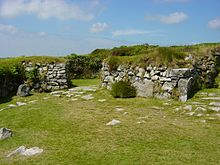- Chysauster Ancient Village
-
Chysauster Ancient Village is a late Iron Age and Romano-British village of courtyard houses in Cornwall, England, United Kingdom, which is currently in the care of English Heritage.[1] To the south east is the remains of a fogou, an underground structure of uncertain function.
The village was believed to have been constructed and occupied between 100 BC and 400 AD; it was primarily agricultural and unfortified and probably occupied by members of the Dumnonii tribe.
The village included eight stone dwellings, arranged in pairs along a street, each with its own garden plot. The houses are oval shaped and around 28 metres long. Their walls survive to heights of up to 3 metres. Small chambers lead off from the main courtyards of each house which served as working and living areas. A field system in the vicinity attests to the site's farming connections. The nearby hill fort of Castle An Dinas may have been a contemporary refuge for the occupants of the village in times of strife.
It has been excavated on many occasions, and some of the reinstatement work which has been carried out over the years has been unsympathetic. Several sections of the village were incorrectly reinstated in the wake of previous excavations.
Contents
Controversy over the site
The fogou nearby was filled in by English Heritage in the 1980s in an attempt to prevent it from caving in, a move which was unpopular with the local community. In the 1990s, archaeologist Craig Weatherhill questioned the then head of English Heritage, Lord Montagu, about the agency's treatment of the fogou. Lord Montagu defended his organisation and Weatherhill was not satisfied. English Heritage was not the only modern agency to affect the Chysauster site; negligent reinstatement work in the wake of earlier excavations resulted in the incorrect placement of some stone walls.[citation needed]
In 1999 there was some further controversy regarding this site and others under the care of the English Heritage organisation. Members of a pressure group, the Revived Cornish Stannary Parliament, removed several signs bearing the English Heritage name.[2][3]
See also
References
- ^ Craig Weatherhill Cornovia: Ancient Sites of Cornwall & Scilly (Alison Hodge 1985; Halsgrove 1997, 2000)
- ^ Cornish Stannary Parliament tackles English cultural aggression in Cornwall.
- ^ BBC News: Historic signs case trio bound over
Further reading
- Cavendish, Richard: Prehistoric England (London, 1983)
- Christie, Patricia Maeve Lascelles: Chysauster Ancient Village, Cornwall (London, English Heritage, 1987)
- Reynolds, P. K. B., Chysauster, Cornwall, Great Britain. Ministry of Public Building and Works (London H.M.S.O., 1960)
External links
- Chysauster Ancient Village information at English Heritage
- Teachers' resources for Chysauster Village: English Heritage
- Hazard information for risk assessment for group leaders: English Heritage
Coordinates: 50°9′39.7″N 5°32′24.8″W / 50.161028°N 5.540222°W
Categories:- Buildings and structures in Cornwall
- English Heritage sites in Cornwall
- History of Cornwall
- Prehistoric sites in Cornwall
- Visitor attractions in Cornwall
- Iron Age sites in Cornwall
- Former populated places in England
- Roman sites in England
Wikimedia Foundation. 2010.

